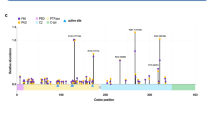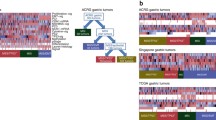Abstract
The p53 tumour-suppressor gene is found altered in the majority of colorectal cancers. Lesions include allelic loss, mutation of the gene and overexpression of the p53 protein. All of these lesions have been analysed for prognostic significance, and whereas both mutation and allelic loss have been shown to be reasonably useful markers of prognosis, the utility of overexpression of the p53 protein is more ambiguous. Given that many authors use p53 overexpression as a marker for point mutation this issue is of some importance. We have therefore examined 100 colorectal carcinomas for mutation of the p53 gene, as well as overexpression of the p53 protein. Results show that whereas mutation of the p53 gene is associated with p53 overexpression, the degree of association depends, at least in part, upon the particular antibody used. Moreover, although mutation of the p53 gene does provide prognostic information, overexpression of the p53 protein, as detected with two antibodies, does not. These results suggest that immunohistochemistry is not a suitable alternative to direct detection of mutation in assessing prognosis in colorectal cancer patients.
Similar content being viewed by others
Author information
Authors and Affiliations
Rights and permissions
About this article
Cite this article
Smith, D., Ji, CY. & Goh, HS. Prognostic significance of p53 overexpression and mutation in colorectal adenocarcinomas. Br J Cancer 74, 216–223 (1996). https://doi.org/10.1038/bjc.1996.340
Issue Date:
DOI: https://doi.org/10.1038/bjc.1996.340
- Springer Nature Limited
This article is cited by
-
Overexpression of TP53 protein is associated with the lack of adjuvant chemotherapy benefit in patients with stage III colorectal cancer
Modern Pathology (2020)
-
Mdm2 inhibition induces apoptosis in p53 deficient human colon cancer cells by activating p73- and E2F1-mediated expression of PUMA and Siva-1
Apoptosis (2011)
-
Could we decide adjuvant therapy of colon cancer based on microarrays?
Current Colorectal Cancer Reports (2007)
-
Relationship between VEGF and p53 expression and tumor cell proliferation in human gastrointestinal carcinomas
Journal of Cancer Research and Clinical Oncology (2007)
-
High incidence of protein-truncating mutations of the p53 gene in liver metastases of colorectal carcinomas
Oncogene (2002)




